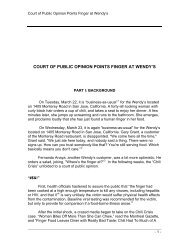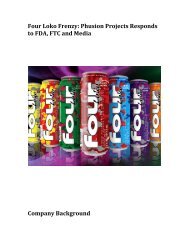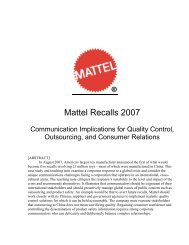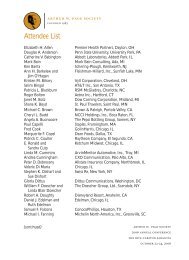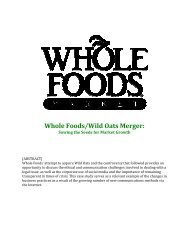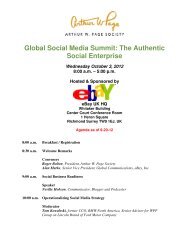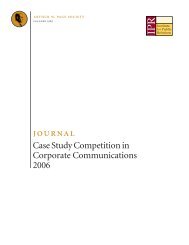Subaru Case Study - The Arthur Page Society
Subaru Case Study - The Arthur Page Society
Subaru Case Study - The Arthur Page Society
Create successful ePaper yourself
Turn your PDF publications into a flip-book with our unique Google optimized e-Paper software.
considered. First, <strong>Subaru</strong> is a small Japanese auto manufacturer offering six automobile models<br />
compared to Ford Motor Co., a large U.S. auto manufacturer offering 16 (consumer) automobile<br />
models. <strong>Subaru</strong> sales represent a mere fraction of Ford’s, and the former has a history of<br />
targeting progressive, liberal niche markets – gay or straight – to sell niche car models. Ford, on<br />
the other hand, is a mainstream brand targeting a wide variety of consumers, both liberal and<br />
conservative. Ford was the sixth largest U.S. advertiser in 2008 spending $1.4 billion, whereas<br />
<strong>Subaru</strong>’s 2008 advertising budget dwarfs in comparison (~$200 million).<br />
Because of their differences, both companies face unique challenges moving forward as<br />
they continue to strengthen and diversify their relationships with gay and lesbian stakeholders.<br />
However, given <strong>Subaru</strong>’s successful relationship cultivation and unwavering commitment to the<br />
gay and lesbian communities, the company’s niche integrated communication efforts have been<br />
more successful than Ford’s – particularly considering how Ford initially handled the AFA<br />
boycott. <strong>Subaru</strong> has positioned itself as more than a car company seeking to capitalize on the<br />
gay/lesbian dollar, but rather as an ally to gay and lesbian stakeholders.<br />
SUBARU’S CURRENT DILEMMA: IMC SUSTAINABILITY<br />
As competition increases and more automotive companies develop relationships with gay<br />
and lesbian stakeholders, <strong>Subaru</strong> will need to retain its competitive advantage using both<br />
advertising and, even more so, public relations tactics. Between 1995 and 2005, <strong>Subaru</strong>’s<br />
competition was largely luxury automotive brands that targeted consumers of a different<br />
socioeconomic status. New gay and lesbian media outlets have appeared regularly within the last<br />
decade, therefore providing fresh, unique, and diverse avenues for <strong>Subaru</strong> to reach its brand loyal<br />
gay and lesbian consumers. As evidenced by <strong>Subaru</strong>’s penchant for sponsoring new gay-targeted<br />
products, if more products are not created in the near future, print readership continues to decline<br />
in general, and advertising audiences and dollars continue to move away from traditional media<br />
sources, <strong>Subaru</strong> must keep diversifying its integrated marketing communication efforts in years<br />
to come. In the highly competitive automotive industry, it is necessary for <strong>Subaru</strong> to prove that<br />
its gay and lesbian IMC strategy is sustainable into the next decade as well.<br />
Furthermore, although a loyal contingent, gay and lesbian consumers represent just one<br />
of <strong>Subaru</strong>’s niche markets. While the market has proven to be a lucrative, loyal consumer base,<br />
not all gays and lesbians consume gay-targeted media and therefore may be unaware of <strong>Subaru</strong>’s<br />
efforts. <strong>The</strong> auto manufacturer needs to reach additional consumers regardless of their sexual<br />
orientation. As Jim Hall, an auto analyst with 2953 Analytics, states, “You don’t grow by selling<br />
to the people you’ve sold to before.” 246 To remain competitive in the U.S. automotive industry in<br />
the long-term, <strong>Subaru</strong> needs to grow its consumer base by pursuing other niche markets without<br />
damaging the relationships it has cultivated thus far.<br />
<br />
27



